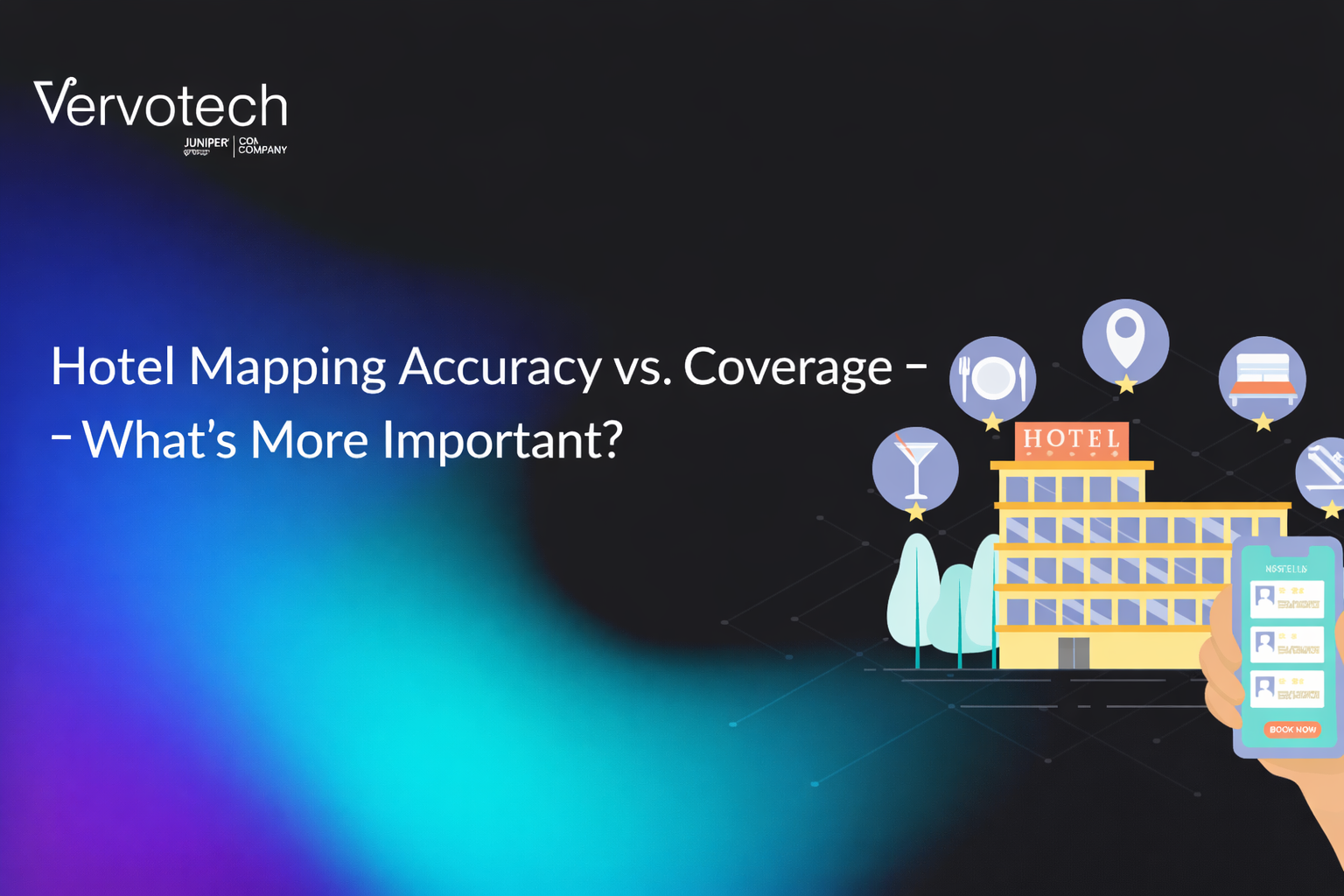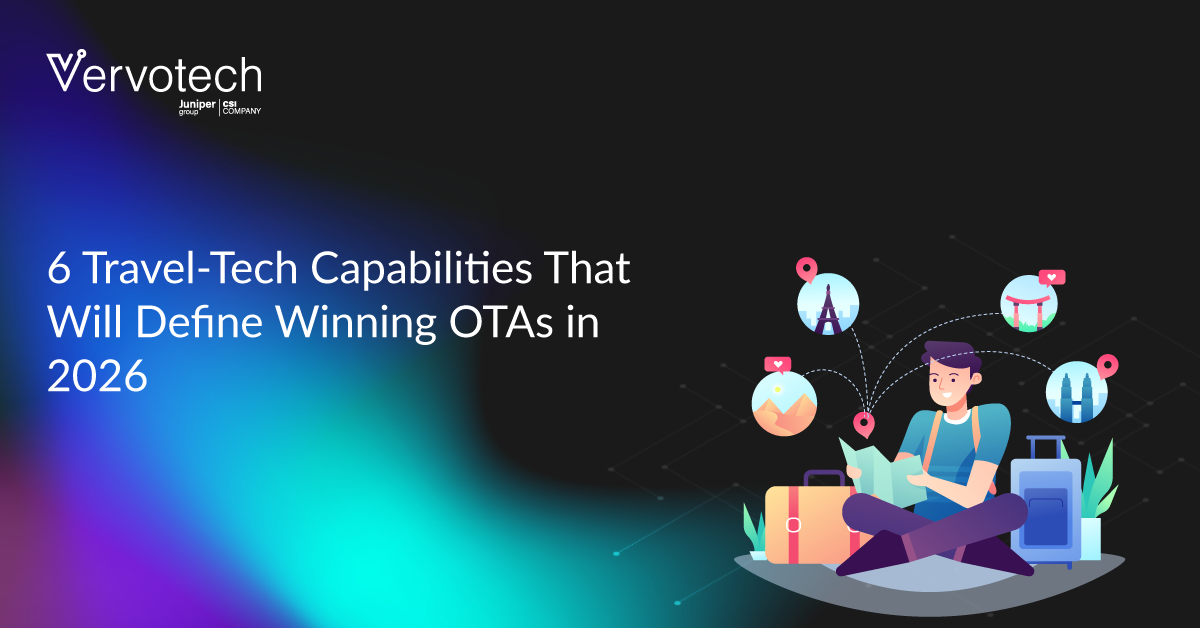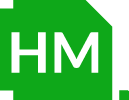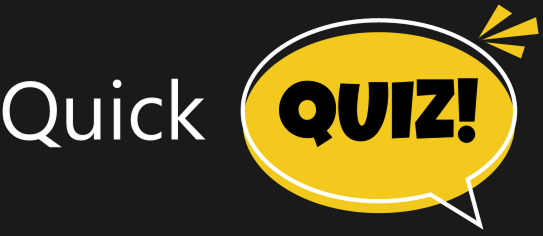Hotel Feeds Need Sensitization Before They Can Be Useful
Here’s why: Hotel distribution is a maze of suppliers, OTAs, OTBs, DMCs, and Bedbanks- each pushing data in their own formats. Every supplier defines its fields differently. Some emphasize property details, some focus on rates, and others skip important attributes like cancellation policies.
If you are an engineer working on integrations in an online travel business, you already know the challenges- duplicates of the same hotel, inconsistent room names, gaps in availability, and missing amenities. When such raw data flows into a booking engine, the outcome is confusing inventory and a poor customer experience.
A clean hotel feed solves this challenge. And that’s what we’re going to discuss in this blog.
We will look at the technical anatomy of a clean hotel feed, what fields matter most, and how hotel mapping and room mapping can help engineers build reliable distribution systems.
Let’s begin by breaking down what makes a feed “clean” from a technical perspective.
TL: DR
- A hotel feed is the backbone of any travel platform, but erroneous data (duplicates, mismatched rooms, missing content) can ruin user trust and conversions.
- The core data structure of a feed must be solid, covering property details, rooms, rates, and supplier data; otherwise, errors multiply downstream.
- Standardization is key: cleaning names, addresses, policies, and amenities ensures consistency across suppliers and improves the traveler’s search experience.
- Going beyond cleanliness, data enrichment (adding verified images, descriptions, star ratings, policies) turns feeds into a competitive advantage.
- Engineers often face pitfalls like duplicate hotels, rate mismatches, and stale content, which frustrate travelers and hurt revenue.
- Best practices for integrators: invest in automation, normalize room categories, enrich content continuously, and monitor anomalies with AI-driven checks.
- Vervotech’s approach combines hotel mapping, room mapping, enrichment, and AI-native mapping, helping online travel platforms deliver clean, reliable feeds that boost conversions and traveler trust.
The Core Data Structure of a Hotel Feed: Building the Foundation
Every clean feed begins with a strong structure. Think of hotel data as a layered model where each entity connects to the next. The hierarchy usually looks like this:
Hotel → property-level information
Rooms → categories within the hotel
Rates → price, inclusions, restrictions
Policies → cancellation, taxes, and rules
Inventory → availability over time
For engineers, this hierarchy creates a predictable pattern that downstream systems can consume. Let’s break down the key fields.
Hotel-level fields
- Hotel ID, which serves as a unique identifier.
- Name, address, and geo-coordinates for location accuracy.
- Brand or chain details.
- Star rating and property type (resort, apartment, hostel).
Room-level fields
- Room type name, capacity, bedding configuration, and amenities.
- Standardized attributes that describe whether it is a Deluxe King, a Standard Twin, or a Suite with Balcony.
Rate-level fields
- Price and currency.
- Rate plan (refundable, non-refundable, meal inclusions).
- Stay restrictions like minimum nights.
Policy and inventory
- Cancellation terms and child policies.
- Date-based availability and blocked dates.
Without this hierarchy, hotel data becomes messy and almost impossible to manage at scale. Next comes the standardization layer.
Now that the building blocks of a feed are clear, the next step is making sure they speak the same language. This is where standardization comes in, transforming raw, inconsistent supplier data into a single, reliable version of the truth.
The Standardization Layer: Where Cleanliness Begins
Once you have a data structure in place, the next step is to map the hotel feed. Think of this as a series of checkpoints that ensure the accuracy of your hotel data.
Step- 1: Identity and duplication checks
Often, the same hotel appears multiple times across suppliers. Without hotel mapping, you end up with the same property under different IDs. For example, “Hilton Garden Inn New York” might also appear as “Hilton NY Garden”. An AI-native hotel mapping api eliminates this duplication and keeps only one master record of the same hotel, thus saving your feed from duplicates that tend to confuse customers and spoil their hotel booking experience.
Also Read: Hotel data duplication: How to solve the growing challenge for hospitality industry
Step- 2: Address and geo verification
An address without geo-coordinates creates confusion. Imagine a hotel pinned three blocks away from its actual location. Validating address & geolocation, including accurate latitude & longitude, ensures the coordinates match the physical address of the hotel. This step again is performed by a hotel mapping api.
Step-3: Room standardization
This is one of the most important parts of the standardization layer, as hotel room names are rarely consistent across multiple suppliers. One supplier lists “King Deluxe,” another lists “Deluxe King Room.” A room mapping api standardizes these variations by clubbing the same room with varied descriptions into one room, so your users see consistent room categories across the hotel feed.
Step-4: Rate and currency validation
When hotel room rates are inconsistent or currencies are missing, pricing errors often occur. Standardization makes sure the rates align with market values and currencies are correctly applied.
Step-5: Content completeness/ curated content
A hotel feed cannot work without images, amenities, and key policies. The standardization ensures that mandatory fields are never empty, so the users can enjoy a confident hotel booking experience.
But standardization alone doesn’t guarantee quality. Once your hotel feed is clean, the question becomes: is it also compelling? That’s where enrichment adds value, filling gaps, refining details, and making data usable not just for machines, but for travelers too.
Enrichment Layer: Turning Clean Data into Smart Data
Even though hotel standardization ensures data accuracy, data accuracy alone doesn’t create a compelling booking experience. Most hotel supplier feeds lack depth. They give you the basics: a property name, a rate, and an address. What they rarely provide is the kind of complete, consistent hotel data that encourages a traveler to trust the listing and complete the booking.
Enrichment fills that gap.
Completeness of content: Imagine a traveler comparing two hotels in Paris. One listing has full descriptions, 25 verified images, and a detailed list of amenities. The other shows only the hotel name and a single outdated photo. Guess which one the traveler books? Enrichment makes sure every hotel has rich descriptions, updated imagery, and accurate amenities.
Localization and multi-currency: Travelers want to shop in their own language and currency. Without enrichment, you end up with English-only descriptions and rates in USD for a customer browsing from Japan. That customer will bounce. Enrichment translates, localizes, and normalizes currencies to improve conversions.
Cross-supplier consistency: Hotels often have different attributes across suppliers. One supplier lists Wi-Fi as free, another as chargeable. Enrichment compares and merges this data into one definitive version. Hotel mapping plays a critical role here, ensuring that all feeds for “Hilton Garden Inn Paris” merge into a single, enriched record.
Smarter categorization: AI and ML can catch anomalies faster than humans. For example, a five-star resort listed with hostel-level amenities is flagged instantly. Enrichment isn’t just about filling gaps; it’s about creating a smarter, more trustworthy dataset.
Without enrichment, even validated feeds remain barebones. With enrichment, hotel data becomes a competitive advantage.
However, sometimes, even with clean and enriched data, things don’t always go as planned. Integrators and engineers often face roadblocks that can derail projects and frustrate business teams. Let’s look at some of the most common pitfalls and why they matter.
Common Pitfalls Engineers Encounter
Integrating hotel data sounds simple on paper, but in reality, engineers encounter landmines that can derail entire projects. Let’s look at the most frequent ones.
Skipping hotel mapping: One of the most damaging mistakes is onboarding supplier feeds without hotel mapping. This creates a nightmare scenario where the same property appears five times under different IDs. The booking engine treats each duplicate as a different hotel, confusing customers and inflating search results with noise.
Inconsistent room naming: Travelers compare room types before making a decision. If one feed lists “Deluxe King” and another lists “King Deluxe,” your platform shows them as two different rooms. Without room mapping, you either confuse the traveler or worse, sell the wrong inventory.
Ignoring metadata: Taxes, cancellation policies, and child age rules might seem like minor fields, but they determine the final price and booking conditions. A hotel priced at $200 could end up costing $240 after taxes. If metadata isn’t standardized and validated, your platform risks misleading the traveler.
Running validations too late: Many engineers apply validations after the feed has already entered production. By then, it’s too late. Stale rates or duplicate hotels are already live, and fixing them damages user trust. Validation must happen at the ingestion stage.
Poor version control: Large inventories are updated frequently. Without version control, platforms can display outdated room details or miss new property additions. The traveler sees the wrong data, and the business loses revenue.
These pitfalls don’t just create technical issues. They directly affect the traveler’s experience and the business’s reputation.
If pitfalls show us what to avoid, best practices highlight the path forward. From integration workflows to continuous validation, here are six actionable practices that can help travel platforms maintain cleaner, more scalable hotel feeds.
Also Read: Hotel Mapping Accuracy vs. Coverage – What’s More Important?
6 Best Practices for Travel Business Integrators
Clean hotel data requires discipline and foresight. The best platforms don’t wait for problems to arise; they design their systems to prevent them. Here’s what we’ve seen work best:
Define a canonical schema before onboarding suppliers: Every supplier has its quirks, so create your own master schema first. Once you have a blueprint, map supplier feeds into it. This avoids inconsistencies at the root.
Automate validations at ingestion: Don’t let bad data slip into production. Build automated pipelines that check addresses, geo-coordinates, room types, rates, and policies as soon as they land.
Leverage hotel mapping aggressively: Duplicate hotels damage user trust. Hotel mapping isn’t optional; it’s essential for merging multiple supplier feeds into a single, reliable record. Without it, you’re building on quicksand.
Normalize rooms with room mapping: Room mapping ensures “Deluxe King” always means the same thing, no matter which supplier provides it. This saves travelers from confusion and platforms from refund claims.
Track everything: Audit logs give visibility into how and when a feed changed. If a property disappears or a rate looks suspicious, logs help you trace the issue quickly.
Test for performance at scale: A feed that works fine with 50,000 properties may break at 500,000. Run stress tests before you scale to avoid system failures during peak booking seasons.
The difference between a feed that works and one that drives conversions lies in these best practices. They transform hotel data from a liability into a growth engine. But of course, theory only takes you so far. To put all this into perspective, let’s walk through how Vervotech approaches clean hotel feeds, combining mapping, enrichment, and AI-driven checks into one streamlined process.
How Vervotech Approaches Clean Hotel Feeds
Clean hotel data directly shapes traveler experience and business outcomes.
At Vervotech, we’ve seen how duplicate listings, inconsistent room categories, and incomplete content derail booking platforms. To solve this, our process starts with hotel mapping, merging millions of supplier feeds into one canonical record. This eliminates duplicates, ensures accuracy of locations, and standardizes every property detail so that platforms show travelers one reliable hotel listing instead of several confusing ones. Room mapping then steps in to normalize categories. Whether a room is labeled “Deluxe King,” “King Deluxe,” or “King Room with Deluxe Amenities,” it appears as a single, clear option. That consistency prevents booking errors and reduces customer support complaints.
Related Read: How Tripjack Used Vervotech Room Mapping Tool To Increase Conversion Rate
But clean data is more than mapping. Our ‘curated content’ feature fills missing images, descriptions, and amenities, while AI-native pipelines continuously validate and refresh the feeds. Suspicious rates or incorrect locations are flagged before they cause problems, which protects both platform reliability and traveler trust.
For engineers, this means fewer sleepless nights chasing errors. For businesses, it means a stronger reputation and higher conversions. For travelers, it means trust & confident hotel bookings.
If your platform is still struggling with duplicates, mismatched rooms, or outdated hotel data, it’s time to rethink your approach.
Vervotech’s hotel mapping and room mapping solutions can give your feeds the clarity and consistency they need to grow. Book a demo today and see how clean hotel data powered by AI-native mapping solutions can make a difference to your travel business.
Frequently Asked Questions (FAQs)
Why is a clean hotel feed so important for travel platforms?
A clean hotel feed ensures accurate property listings, room details, and rates. Without it, travelers face mismatched bookings, duplicate properties, or missing amenities, all of which erode trust and lead to abandoned bookings.
Can’t manual data cleaning solve feed quality issues?
Manual cleaning may work for small datasets, but hotel content changes daily across thousands of suppliers. Scaling this manually is impossible; automation and AI-driven mapping are the only sustainable solutions.
What’s the difference between data standardization and enrichment?
Standardization ensures consistency, fixing names, addresses, room types, and amenities. Enrichment goes further, adding missing information (images, policies, star ratings, reviews), making the feed not just clean but competitive.
How do duplicate hotel listings affect revenue?
Duplicates split bookings between multiple listings of the same hotel, lowering visibility, ranking, and conversions. Worse, they confuse travelers, who may drop off entirely instead of taking the risk.
How does Vervotech ensure feed accuracy?
Vervotech uses AI- native hotel and room mapping APIs, automated enrichment pipelines, and continuous monitoring to detect anomalies. This results in 99.999%+ mapping accuracy and reliable, conversion-friendly hotel feeds for its customers.
